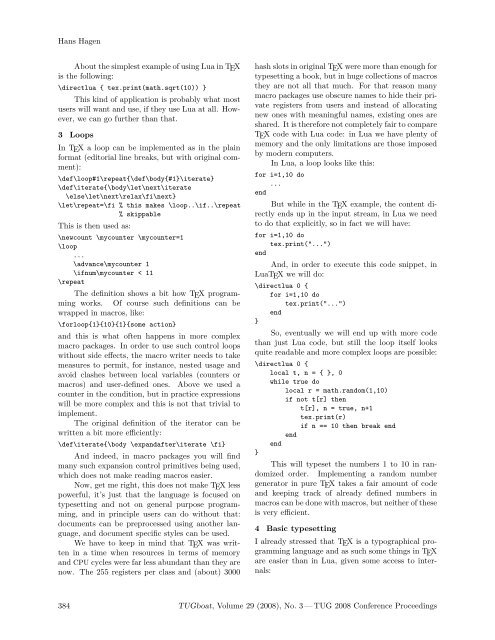The Communications of the TEX Users Group Volume 29 ... - TUG
The Communications of the TEX Users Group Volume 29 ... - TUG
The Communications of the TEX Users Group Volume 29 ... - TUG
You also want an ePaper? Increase the reach of your titles
YUMPU automatically turns print PDFs into web optimized ePapers that Google loves.
Hans Hagen<br />
About <strong>the</strong> simplest example <strong>of</strong> using Lua in <strong>TEX</strong><br />
is <strong>the</strong> following:<br />
\directlua { tex.print(math.sqrt(10)) }<br />
This kind <strong>of</strong> application is probably what most<br />
users will want and use, if <strong>the</strong>y use Lua at all. However,<br />
we can go fur<strong>the</strong>r than that.<br />
3 Loops<br />
In <strong>TEX</strong> a loop can be implemented as in <strong>the</strong> plain<br />
format (editorial line breaks, but with original comment):<br />
\def\loop#1\repeat{\def\body{#1}\iterate}<br />
\def\iterate{\body\let\next\iterate<br />
\else\let\next\relax\fi\next}<br />
\let\repeat=\fi % this makes \loop..\if..\repeat<br />
% skippable<br />
This is <strong>the</strong>n used as:<br />
\newcount \mycounter \mycounter=1<br />
\loop<br />
...<br />
\advance\mycounter 1<br />
\ifnum\mycounter < 11<br />
\repeat<br />
<strong>The</strong> definition shows a bit how <strong>TEX</strong> programming<br />
works. Of course such definitions can be<br />
wrapped in macros, like:<br />
\forloop{1}{10}{1}{some action}<br />
and this is what <strong>of</strong>ten happens in more complex<br />
macro packages. In order to use such control loops<br />
without side effects, <strong>the</strong> macro writer needs to take<br />
measures to permit, for instance, nested usage and<br />
avoid clashes between local variables (counters or<br />
macros) and user-defined ones. Above we used a<br />
counter in <strong>the</strong> condition, but in practice expressions<br />
will be more complex and this is not that trivial to<br />
implement.<br />
<strong>The</strong> original definition <strong>of</strong> <strong>the</strong> iterator can be<br />
written a bit more efficiently:<br />
\def\iterate{\body \expandafter\iterate \fi}<br />
And indeed, in macro packages you will find<br />
many such expansion control primitives being used,<br />
which does not make reading macros easier.<br />
Now, get me right, this does not make <strong>TEX</strong> less<br />
powerful, it’s just that <strong>the</strong> language is focused on<br />
typesetting and not on general purpose programming,<br />
and in principle users can do without that:<br />
documents can be preprocessed using ano<strong>the</strong>r language,<br />
and document specific styles can be used.<br />
We have to keep in mind that <strong>TEX</strong> was written<br />
in a time when resources in terms <strong>of</strong> memory<br />
and CPU cycles were far less abundant than <strong>the</strong>y are<br />
now. <strong>The</strong> 255 registers per class and (about) 3000<br />
hash slots in original <strong>TEX</strong> were more than enough for<br />
typesetting a book, but in huge collections <strong>of</strong> macros<br />
<strong>the</strong>y are not all that much. For that reason many<br />
macro packages use obscure names to hide <strong>the</strong>ir private<br />
registers from users and instead <strong>of</strong> allocating<br />
new ones with meaningful names, existing ones are<br />
shared. It is <strong>the</strong>refore not completely fair to compare<br />
<strong>TEX</strong> code with Lua code: in Lua we have plenty <strong>of</strong><br />
memory and <strong>the</strong> only limitations are those imposed<br />
by modern computers.<br />
In Lua, a loop looks like this:<br />
for i=1,10 do<br />
...<br />
end<br />
But while in <strong>the</strong> <strong>TEX</strong> example, <strong>the</strong> content directly<br />
ends up in <strong>the</strong> input stream, in Lua we need<br />
to do that explicitly, so in fact we will have:<br />
for i=1,10 do<br />
tex.print("...")<br />
end<br />
And, in order to execute this code snippet, in<br />
Lua<strong>TEX</strong> we will do:<br />
\directlua 0 {<br />
for i=1,10 do<br />
tex.print("...")<br />
end<br />
}<br />
So, eventually we will end up with more code<br />
than just Lua code, but still <strong>the</strong> loop itself looks<br />
quite readable and more complex loops are possible:<br />
\directlua 0 {<br />
local t, n = { }, 0<br />
while true do<br />
local r = math.random(1,10)<br />
if not t[r] <strong>the</strong>n<br />
t[r], n = true, n+1<br />
tex.print(r)<br />
if n == 10 <strong>the</strong>n break end<br />
end<br />
end<br />
}<br />
This will typeset <strong>the</strong> numbers 1 to 10 in randomized<br />
order. Implementing a random number<br />
generator in pure <strong>TEX</strong> takes a fair amount <strong>of</strong> code<br />
and keeping track <strong>of</strong> already defined numbers in<br />
macros can be done with macros, but nei<strong>the</strong>r <strong>of</strong> <strong>the</strong>se<br />
is very efficient.<br />
4 Basic typesetting<br />
I already stressed that <strong>TEX</strong> is a typographical programming<br />
language and as such some things in <strong>TEX</strong><br />
are easier than in Lua, given some access to internals:<br />
384 <strong>TUG</strong>boat, <strong>Volume</strong> <strong>29</strong> (2008), No. 3 — <strong>TUG</strong> 2008 Conference Proceedings

















